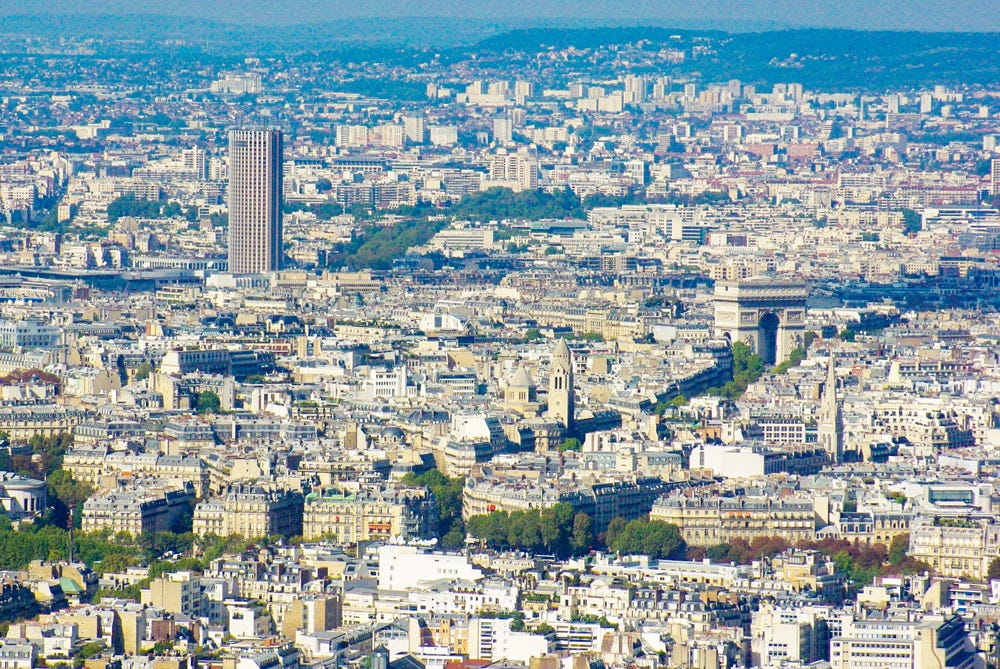Paris vs. London: The Skyline Story You Didn’t Expect
How Paris Kept Its Skyline Intact While London Reached for the Sky
This week, something popped up on my Facebook feed that made me stop scrolling.
It was one of those "before and after" comparison posts—two photos of London’s skyline from the same spot, decades apart.
The first was a black-and-white shot from the 1950s, showing St Paul's Cathedral rising majestically above the rooftops.
The second, taken in 2024, was a completely different picture.
Skyscrapers, glass towers, modernity pressing in from all sides.
St Paul's was still there, but it looked... diminished. Swallowed by the steel and glass jungle of the City.
Then I noticed a comment beneath the post: "It's pretty terrible now, isn't it? If they wanted to do skyscrapers, they should have kept them well away from that view."
And you know what? That’s exactly what Paris did.
Two Cities, Two Different Approaches
London and Paris, both grand old capitals with centuries of history, took radically different paths when it came to skyscrapers.
In London, modernity barged right into the heart of the city.
Paris, on the other hand, kept its towers at arm’s length.
In London, the skyline started changing in the 1980s and 1990s, but it was the 2000s that truly transformed it.
The Gherkin (30 St Mary Axe), the Walkie-Talkie (20 Fenchurch Street), the Cheesegrater (122 Leadenhall Street)—buildings with quirky nicknames, rising up right in the historic core.
And then there’s Canary Wharf, another forest of skyscrapers, built on the old docklands.
London didn’t hesitate to let the modern and the historic collide.
Paris? Completely different strategy.
Instead of allowing skyscrapers to muscle into the historic centre, it built La Défense, a business district just beyond the city limits, where towers could grow as tall as they liked without disrupting the classical skyline.
The tallest, Tour First, reaches 231 metres.
But come 2025, it will be surpassed by The Link, a 244-metre skyscraper currently under construction in La Défense, set to become the highest in France.
Not quite Shard-level (310 metres), but tall enough to make an impact.
The Montparnasse "Mistake"
Paris did try the skyscraper thing once. It didn’t go well.
In the early 1970s, the city decided to build a modern high-rise right in the middle of Paris.
The result? Tour Montparnasse—a 210-metre monolith of dark glass that immediately became one of the most hated buildings in the city.
To this day, it’s widely considered an eyesore.
The kind of building that, if you’re on top of it, at least you don’t have to see it.
Montparnasse was a turning point.
After its completion, Paris essentially said: "Never again."
By 1977, new height restrictions were introduced, capping buildings at 31 metres (about six or seven storeys).
This rule helped preserve the city’s distinctive low-rise, uniform skyline—Haussmann’s grand boulevards, zinc rooftops, and a sense of visual harmony.
The Debate Over New Towers
But things are shifting.
In 2010, Paris loosened its rules a little, allowing buildings up to 50 metres (residential) and 180 metres (office towers) in select areas.
The idea? Encourage modern development without sacrificing the city's unique aesthetic.

And now, there’s the Tour Triangle.
If you haven’t heard of it, it's a 180-metre pyramid-like skyscraper, designed by Herzog & de Meuron, set to be built at the edge of the 15th arrondissement, near the city’s limits.
And, predictably, it's stirred up controversy.
Some say it's a bold move, a sign that Paris is embracing modernity.
Others argue it's another Montparnasse in the making—an intrusive, misplaced attempt at skyscraper fever.
The debate goes beyond aesthetics.
Paris has a housing crisis, a growing population, and skyrocketing rents.
Some argue that building higher is the only way forward.
But at what cost? If skyscrapers start creeping into the city, does Paris risk losing its identity?
The Final Question
Walking around Paris today, you notice something: the sky feels open.
There’s space to breathe. You can look up and still see history on the rooftops.
Would that change if glass towers started rising among the domes and spires?
London made its choice. It let skyscrapers redefine its skyline.
Paris made a different call. It pushed them to the outskirts, keeping its historic centre untouched.
Which is the better decision?
That depends on who you ask.
Some love London’s bold mix of old and new.
Others feel something was lost in the process. Paris, for now, has chosen to keep its past intact.
The question is: how much longer can it hold out?
But the question remains—will Paris hold the line forever, or is it only a matter of time before the towers find their way in?










It depends who and what you think a city centre is for, doesn’t it? Personally I don’t like skyscrapers- to me they scream that this building wasn’t created for humans, and the wind tunnels they create are horrible to navigate, especially if you have to do so daily. I had to work in Canary Wharf for a couple of years and deeply loathed everything about it, but especially the fact that nothing is on a human scale. But for a long time now, the City of London has been a business district within which St Paul’s is stranded as a memento of a very different era. Very few people live in the City, and it’s not a big draw for tourism or leisure activities- it feels very dead at the weekend. Is it really comparable to the centre of Paris?